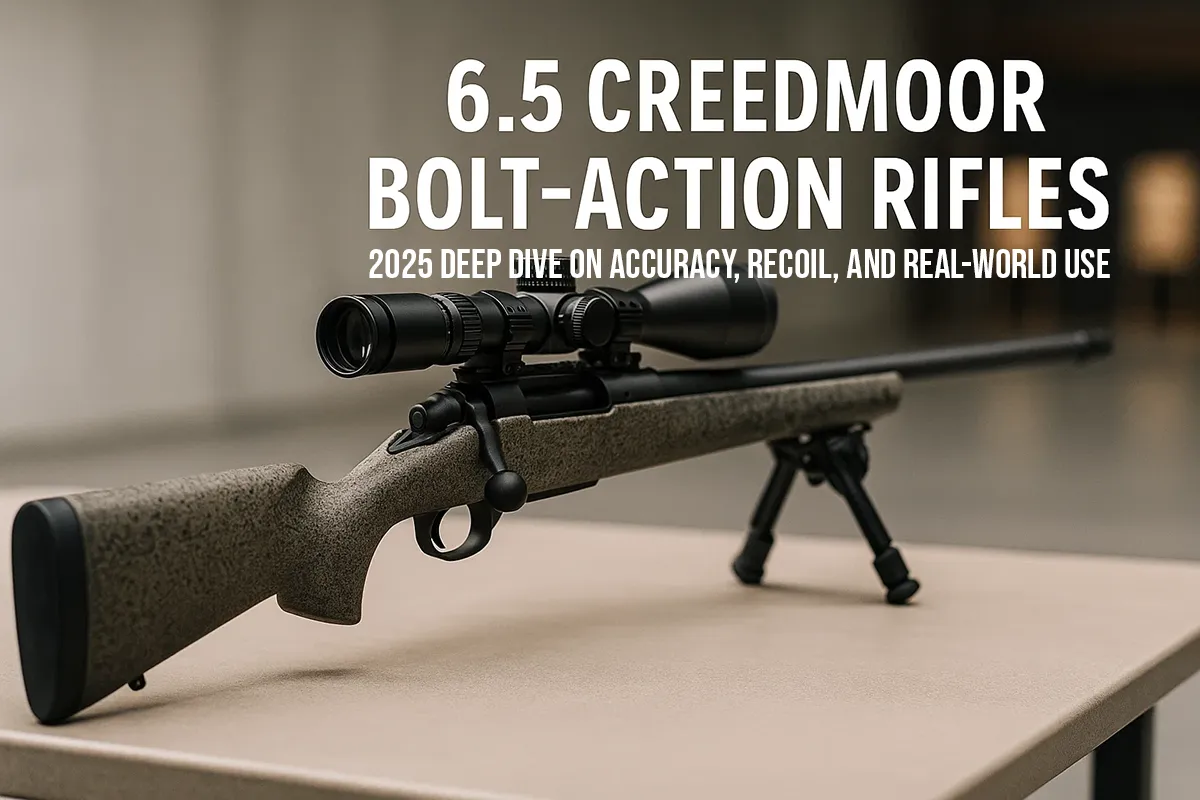6.5 Creedmoor Bolt-Action Rifles: 2025 Deep Dive on Accuracy, Recoil, and Real-World Use
November 24, 2025

6.5 Creedmoor bolt-action rifles deliver repeatable accuracy with mild recoil, broad ammo availability, and versatile performance from steel plates to deer and pronghorn. If you want an approachable path to distance shooting without punishing blast, this is a smart place to start.
On November 21, 2025, we took stock of where 6.5 Creedmoor bolt-action rifles stand for U.S. shooters. The short version: they’re still thriving because they strike a rare balance—flat-enough trajectory, manageable recoil, and wide rifle selection from value-priced hunting rigs to competition-leaning chassis guns. This guide cuts through jargon, explains tradeoffs, and points you to core categories and brands on GunGenius so you can choose with confidence.
The Trend
The 6.5 Creedmoor grew from a precision target round into a mainstream hunting and general-purpose choice. What keeps it sticky in 2025 is how well it scales: entry rifles hit sub-MOA potential with factory loads, while higher-end builds stretch confidently past typical hunting distances. For a new long-range shooter, the softer recoil helps you stay in the scope to spot hits and misses—your shoulder (and learning curve) will thank you.
Why 6.5 Creedmoor bolt-action rifles still rule the ridge
- Accuracy headroom: Modern 6.5 CM loads and barrels make it easier for new shooters to see “precision” results without handloading.
- Manageable recoil: Compared with .308 Winchester, most shooters find it easier to practice more often and maintain good fundamentals.
- Forgiving ballistics: Sleek, high-BC bullets carry velocity, which flattens your curve and widens the “acceptable” window on wind calls for learners.
- Rifle choice: From budget sporters to carbon-barrel mountain rigs and PRS-ready chassis rifles, options exist at every price tier.
- Accessory ecosystem: 5/8×24 threaded muzzles, AICS-pattern magazines, and 20 MOA rails are common, simplifying upgrades later.
Spec Highlights & Standouts
- Barrel length: 20–22 inches suits most hunters and general users—compact enough in the woods with minimal velocity loss. Go 24–26 inches if you prioritize steel at distance.
- Twist rate: 1:8 is common and stabilizes popular 120–147 grain bullets well.
- Weight envelope: 6.5–8.5 lb bare rifle is the sweet spot for carry-ability without giving up shootability from field positions.
- Triggers: User-adjustable ~2.5–4 lb triggers are increasingly standard; crisp, consistent breaks matter more than ultralight pulls.
- Stocks & chassis: Classic synthetic stocks are light and quiet in brush; chassis systems add adjustability and accessory mounting for range days or comps.
- Threaded muzzles: Look for factory threading if you plan to add a brake or suppressor—common on new models and a nice future-proof feature.
Comparisons
If you’re primarily a hunter who walks more than you shoot, a trim sporter makes sense. Brands like Savage, Tikka, Ruger, and Bergara offer lightweight, accuracy-focused 6.5 Creedmoor rifles with practical features (threaded barrels, detachable mags). Chassis-style rifles add weight and adjustability, trading a bit of carry comfort for shootability when you’re dialing dope and working stages at the range. If you’re cross-shopping calibers, .308 Winchester remains a solid all-rounder with broader “legacy” ammo choices, but you’ll usually give up a touch of flatness and pick up a bit of recoil compared with 6.5 CM.
Use Cases
Whitetail & antelope: With appropriate bullets, 6.5 CM shines in open-country hunts where wind and range estimation matter. A 20–22 inch sporter, a simple 3–9x or 4–16x optic, and a sling will cover most North American deer and pronghorn scenarios.
Steel from 300–1,000 yards: Mild recoil and abundant match ammo make it easier to learn wind and elevation holds. A heavier rifle with a quality adjustable stock or chassis helps you stay steadier through the shot.
Training & fundamentals: Because the cartridge is forgiving, you can focus on building position, breathing, and trigger control instead of bracing for recoil. That translates directly to better field confidence.
Suppressed shooting: Many factory rifles in 6.5 CM are suppressor-ready. Expect friendlier blast and easier communication on the line, with a slight increase in overall length when running a can.
Shopping Smart: Features to Prioritize
- Barrel quality & contour: Look for consistent groups as the barrel heats. Lighter barrels carry better; medium contours stay steadier in strings.
- Stock fit: Comb height and length of pull matter. Adjustable cheekpieces or spacers help you get behind the scope comfortably.
- Magazine pattern: AICS-pattern mags are widely supported; rotary or proprietary mags can work fine—just confirm availability and cost.
- Rail & base: A built-in 20 MOA rail gives extra elevation for distance work; otherwise budget for a quality base and rings.
- Trigger adjustability: The ability to fine-tune down to ~2.5–3 lb safely is a plus for precision work.
Ready to compare across makes and budgets? Start with our Bolt-Action Rifles category to see how features and prices stack up across the market.
What to Watch Next
Expect more factory-threaded muzzles, lighter carbon and composite stocks, and “do-it-all” trims that blur hunting and competition roles. Also watch for bundled packages—rifle, optic, rings—tuned for new shooters who want to skip piecemeal shopping and get to the range sooner.
Browse related models on Bolt-Action Rifles, and keep an eye on brand lineups from Tikka, Savage, and Bergara as new trims land.